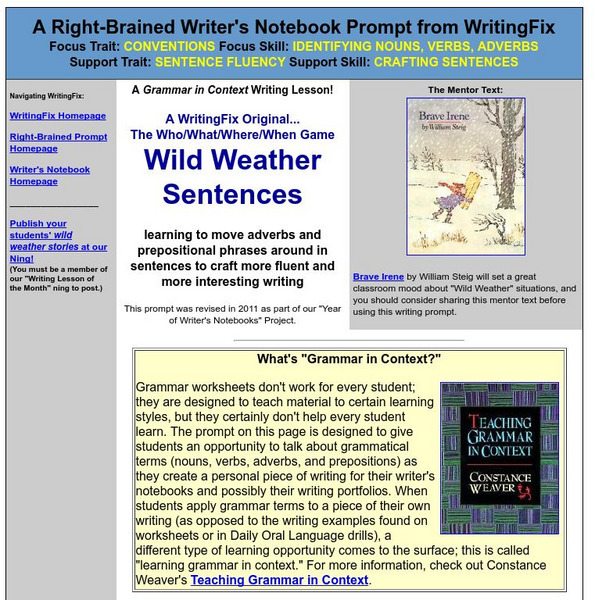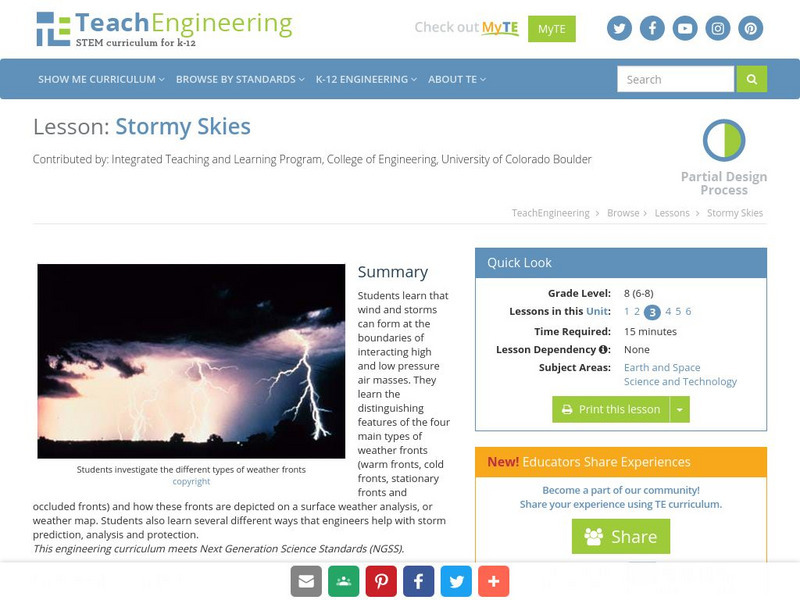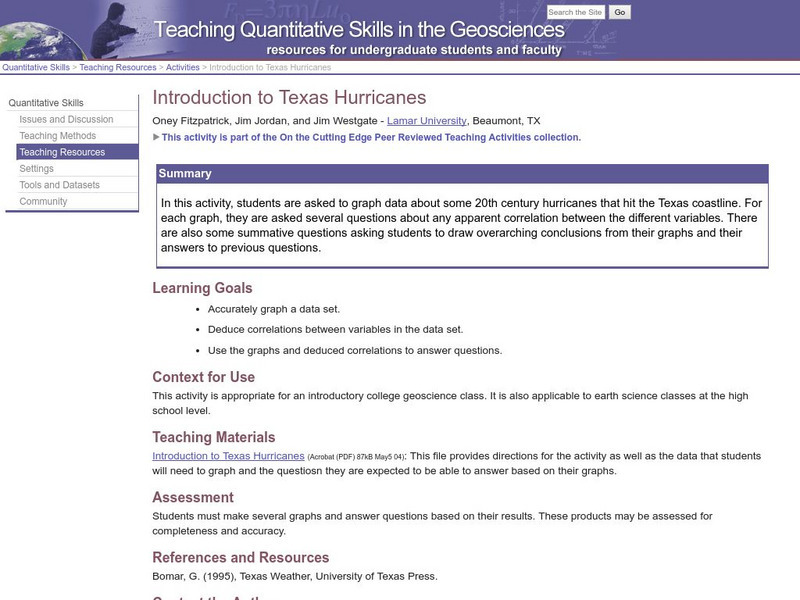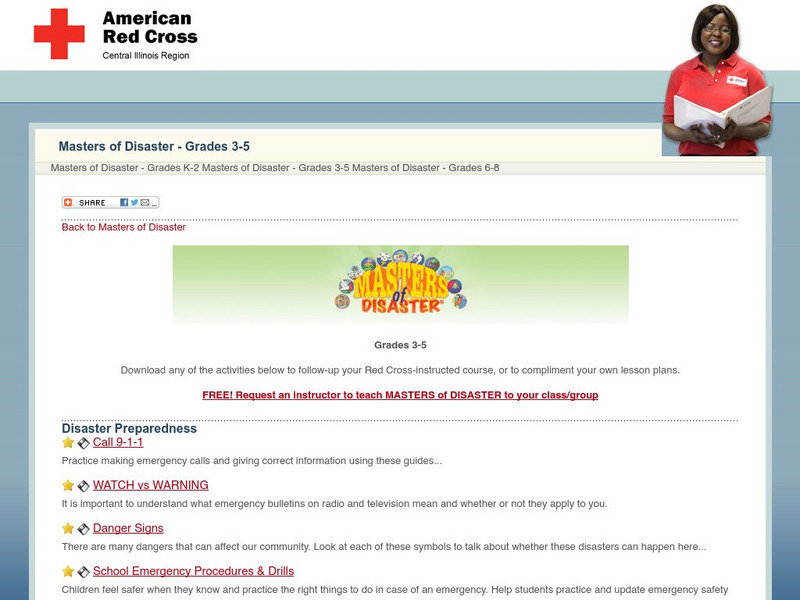Hi, what do you want to do?
Children's Museum
The Children's Museum of Indianapolis: Weather: Twirly Whirly Tornado
In this lesson, students will witness the creation of a funnel, observe how a funnel moves debris, and learn how a thunderstorm can create tornados.
NASA
Nasa: Precipitation Towers: Modeling Weather Data
This lesson uses stacking cubes as a way to graph precipitation data, comparing the precipitation averages and seasonal patterns for several locations. Variations on the lesson can accommodate various ages and ability levels. Students...
Texas State Historical Association
Texas State Historical Association: Weather in Texas [Pdf]
An activity guide where students refer to the Texas Almanac, which is free to download, for information needed to complete assigned tasks. In this lesson, they investigate typical Texas weather, significant weather events such as...
University Corporation for Atmospheric Research
Ucar: Tornadoes Teaching Box
In this teaching box are resources to help students learn why and where tornadoes happen and how these weather events impact people's lives.
Climate Literacy
Clean: A Global Issue: The Impacts of Climate Change
This is lesson five of a 9-lesson module. Activity explores the effects of climate change on different parts of the Earth system and on human well-being: polar regions, coral reefs, disease vectors, extreme weather, and biodiversity.
Writing Fix
Writing Fix: The Who/what/where/when Game: Wild Weather Sentences
In this lesson, Teaching Grammar in Context by Constance Weaver provides foundational information for this lesson. Brave Irene, written by William Steig, is used as the mentor text of this lesson. Students will develop sentences with...
TeachEngineering
Teach Engineering: Stormy Skies
Learners learn that wind and storms can form at the boundaries of interacting high and low pressure air masses. They learn the distinguishing features of the four main types of weather fronts (warm fronts, cold fronts, stationary fronts...
Better Lesson
Better Lesson: Design Solutions Engage, Explore
Third graders illustrate and write out notes for a plan (or several plans) to mitigate the effects of a local weather hazard.
University Corporation for Atmospheric Research
Ucar: Differences Between Climate and Weather
In this activity, young scholars collect weather data over several days or weeks, graph temperature data, and compare the temperature data collected with averaged climate data where they live.
TeachEngineering
Teach Engineering: Global Climate Change
Students learn how the greenhouse effect is related to global warming and how global warming impacts our planet, including global climate change. Extreme weather events, rising sea levels, and how we react to these changes are the main...
Other
American Red Cross: Masters of Disaster: Grades 6 8
This resource presents many science lessons with related activities for students in grades 6-8. Content addresses tools for coping with disasters such as tornadoes, fires, lightning, floods and general preparedness.
Science Education Resource Center at Carleton College
Serc: Introduction to Texas Hurricanes
In this activity, students are asked to graph data about some 20th century hurricanes that hit the Texas coastline. For each graph, they are asked several questions about any apparent correlation between the different variables. Students...
Library of Virginia
Virginia Memory: Death or Liberty: Gabriel's Rebellion
This lesson explores the Gabriel Rebellion of 1800 where an intended slave rebellion led by a slave never got off the ground due to the extreme weather that disrupted plans. Gabriel, the slave, was literate and was influenced by...
Other
American Red Cross: Masters of Disaster: Grades 3 5
This resource provides many science lessons with related activities for children in grades 3-5 regarding disaster preparedness. The resource covers tornadoes, fires, lightning, floods and general preparedness information.
Utah Education Network
Uen: Sun or Shade?
Use a thermometer to measure the air temperature in several places around the school.
NOAA
Noaa: Ocean Explorer: Aerial Photography & Mapping Lesson Plan: Images of Katrina
This activity from NOAA Ocean Service is about using aerial photographs to assess the impact of extreme weather events such as Hurricane Katrina. The activity features aerial views of Biloxi, MS post-Katrina and enables students to see...
PBS
Pbs Teachers: Warnings From the Ice
Examine equipment used for cold-weather survival, identify pack items students consider essential and collaborate to plan a survival pack for severe Antarctic weather.
Science Education Resource Center at Carleton College
Serc: Drought
The unit teaches students to interpret climate data to recognize the symptoms and evaluate the severity of drought. It helps them realize that drought can still devastate areas that have stable infrastructure and access to expensive...
Other
American Red Cross: Masters of Disasters: Grades K 2
This resource presents many lessons with activities to engage students in grades K-2 in learning about disaster preparedness including fires, lightning, tornadoes, floods and general preparedness. Download any of the activities below to...
University Corporation for Atmospheric Research
Ucar: El Nino Teaching Box
This Teaching Box combines readings and activities to build student understanding of the changes that happen during an El Nino event.
University Corporation for Atmospheric Research
Ucar: Flash Floods Teaching Box
This teaching box is filled with explorations and readings that help secondary students learn the science of flash flooding.
PBS
Pbs Teachers: Ocean Activity Ideas
Explore ocean habitats, learn about the extreme weather of the ocean and examine environmental threats to the ocean. Conduct experiments on buoyancy and osmosis, and research sailing and ocean-based industry.
Alabama Learning Exchange
Alex: Researching Hurricanes With Technology
This instructional activity will help young scholars to understand the formation, power, and history of hurricanes. Students will do this using a combination of technological skills. Examples of technology used include: PowerPoint, Word,...
Science Education Resource Center at Carleton College
Serc: Impact of Natural Disasters on the Earth
Through demonstrations and other research, students explore the impact of various natural disasters on the earth. The disasters include floods, tornadoes, hurricanes, volcanoes, and earthquakes.
Other popular searches
- Extreme Weather Lesson Plans
- Severe Weather Activities
- Severe Weather Safety
- Severe Weather Phenomenon
- Severe Weather Patterns
- Severe Weather Unit
- Effects of Severe Weather
- Severe Weather Lesson Plans
- Extreme Weather Project
- Extreme Weather Book Reports
- Living With Extreme Weather
- Causes of Severe Weather





















